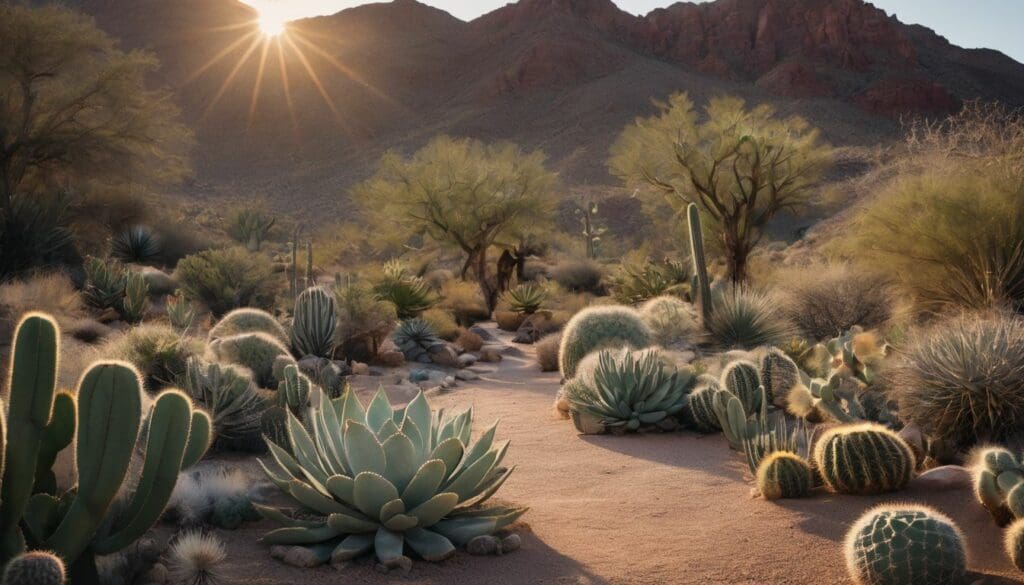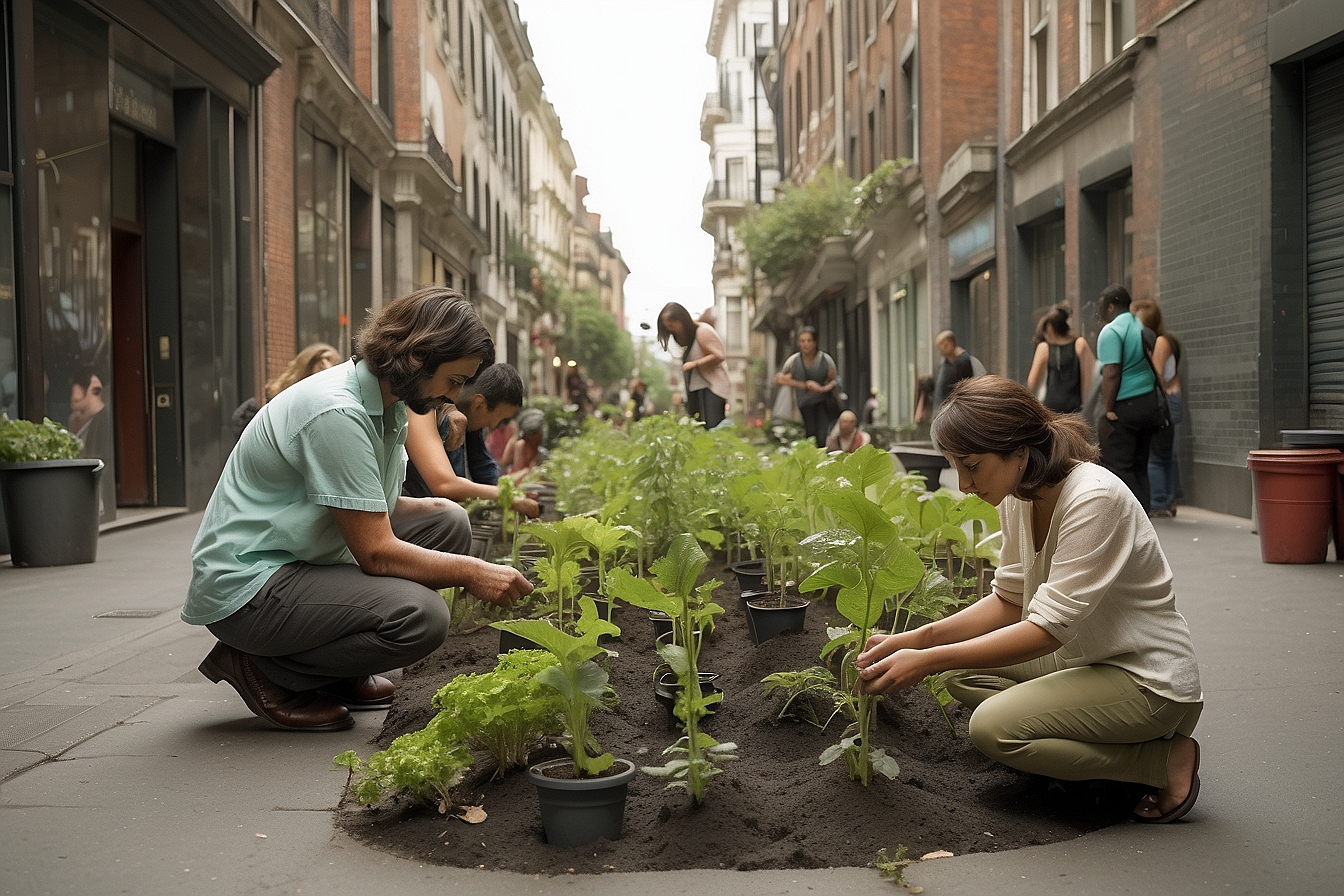Are you wrestling with a parched garden during these water-wise days? Well, fret not – we’re in the same boat, rolling up our sleeves to sniff out those gardening tactics that flourish even when moisture is meagre.
Our little adventure has led us to xeriscaping – it’s quite the clever approach for creating verdant vistas that barely bat an eyelid at the watering can. Ready to dive into some drought-defying greenery? Let’s transform barren patches into breathtaking splendour together!
Key Takeaways
- Xeriscaping is a sustainable gardening method focused on water conservation by using drought-tolerant plants and efficient irrigation like drip systems.
- It involves smart planning, soil improvement with organic matter for better moisture retention, careful plant selection, mulching to reduce evaporation, and regular maintenance for healthy growth.
- Diverse garden types can benefit from xeriscaping principles, including hell strip gardens by roadways, container gardens for limited spaces, and hardscape gardens that use rocks and gravel to minimise water use.
- The benefits of xeriscaping include significant reductions in water usage which helps the environment and lowers water bills. Moreover, it requires lower maintenance than traditional landscaping due to slow-growing native plants.
- To add beauty to xeric landscapes while saving water, integrate colourful drought – resistant plants and hardscaping elements that provide visual interest without needing frequent watering or care.
What is Xeriscaping?
Xeriscaping is a method of landscaping that reduces the need for irrigation and promotes water conservation. It involves thoughtful planning, soil improvement, appropriate plant selection, and efficient irrigation to create beautiful, sustainable gardens.
Principles of Xeriscaping
We understand the importance of conserving water and creating beautiful, resilient gardens. Here’s how we harness the principles of xeriscaping to achieve both.
- Start with a comprehensive plan: Before digging into the soil, we map out our garden’s design. This includes studying our area’s climate and envisioning how each section will flourish with minimal water.
- Improve the earth beneath us: Soil improvement is a must for water conservation. We enrich it with organic matter so that it holds moisture better and provides nutrients to drought-tolerant plants.
- Choose the right green companions: Our plant selection focuses on species that thrive in arid conditions. Succulents and slow-growing plants are among our favourites because they require less H2O.
- Cut down on thirst: Efficient irrigation systems, like drip irrigation or soaker hoses, deliver water directly to plant roots without waste.
- Mulch generously: We use mulch to reduce surface evaporation from the soil. It also keeps weeds at bay which compete with our plants for precious moisture.
- Maintain smartly: Our garden upkeep involves pruning, weeding, and monitoring plant health to ensure they grow strong without extra watering.
Planning and Design
When designing a xeriscape, consider the layout and arrangement of plants in the landscape. Position taller drought-resistant plants at the back to create depth, with shorter varieties at the front for visual interest.
Use landscaping tools such as gravel or low-water ground cover to break up open spaces and add texture to your design. This approach minimises water usage while maintaining an attractive outdoor environment.
To plan efficiently, assess sun exposure and wind patterns in your garden. This will help determine which areas are suitable for different types of plants and hardscaping elements.
Soil Improvement
To improve soil for xeriscaping, we enrich it with organic matter like compost and well-rotted manure. This helps enhance water retention and nutrient content, promoting healthier plant growth in arid conditions.
Additionally, we aerate the soil to improve drainage and prevent waterlogging, creating an optimal environment for drought-resistant plants to thrive.
We use mulch on the soil surface to reduce moisture evaporation, suppress weed growth, and insulate roots from extreme temperatures. Mulching also contributes organic matter as it breaks down over time, further improving the soil structure.
Appropriate Plant Selection
Choosing the right plants for xeriscaping is crucial. The key is to select drought-resistant species that thrive in dry conditions, such as succulents, perennials like lavender and yarrow, and ornamental grasses.
Incorporating native plants in your landscape design can also enhance its sustainability, as these are naturally suited to the local climate and soil conditions.
Consider low-water-use plants such as agave or cacti, which require minimal irrigation once established. Prioritise slow-growing species that can adapt to arid environments without needing excessive care or water.
Efficient Irrigation
Efficient irrigation is essential for xeriscaping, as it helps conserve water in environmentally friendly landscaping. Drip irrigation systems are effective in delivering water directly to the plant roots, minimising evaporation and runoff.
Mulching also plays a crucial role in retaining soil moisture, reducing the need for frequent watering. Additionally, incorporating rainwater harvesting techniques further enhances water conservation efforts.
Moving on to “Types of Xeric Gardens”, let’s explore various garden design options suitable for different spaces.
Types of Xeric Gardens
When it comes to xeriscaping, there are various types of gardens you can create to suit your space and preferences. Whether it’s a hell strip garden by the roadside, a container garden on your patio, or a hardscape garden with minimal plantings, each type has its own unique charm and benefits.
Hell Strip Gardens
Hell Strip Gardens, also known as parkway gardens or boulevard gardens, are the narrow strips of land between the sidewalk and the street. These spaces often go unused, but they have great potential for xeriscaping.
By incorporating drought-resistant plants and water-saving landscaping techniques, hell strip gardens can transform an overlooked area into an eye-catching display of sustainable beauty.
Using low-water gardening principles in hell strip gardens not only enhances curb appeal but also helps to conserve water resources. Selecting slow-growing plants that thrive in dry conditions and require minimal irrigation is key to creating a successful hell strip garden.
Container Gardens
Moving on from Hell Strip Gardens, container gardens are another versatile xeric gardening option. Container gardens offer the flexibility to grow drought-tolerant plants in small or limited spaces, making them an ideal choice for urban dwellers or those with minimal outdoor areas.
Utilising containers also allows for better control over soil conditions and drainage, critical factors in successful xeriscaping. By incorporating a variety of textures, heights, and colours using slow-growing and water-saving plants such as succulents and cacti, container gardens can bring a touch of natural beauty to any setting while conserving water and supporting sustainability efforts.
Container gardens present an excellent opportunity to showcase your creativity by arranging different plant combinations within diverse types of containers like terracotta pots, wooden crates or upcycled items.
Hardscape Gardens
Hardscape gardens incorporate non-living elements such as rocks, gravel, and pavers to create visually appealing landscapes with minimal water usage. Utilising hardscaping in xeric gardening can reduce the need for traditional lawns, which require substantial water resources for upkeep.
By incorporating hardscape features into your xeriscape design, you can create beautiful outdoor spaces that are both sustainable and eco-friendly.
Incorporating hardscaping in your xeric garden also provides practical benefits. Hardscape elements help to control erosion and drainage while adding texture and visual interest to the landscape.
The Benefits of Xeriscaping
Xeriscaping offers numerous benefits, including water conservation, low maintenance landscaping and sustainability practices that are beneficial for the environment. By incorporating xeric gardens into your landscape design, you can enjoy a beautiful and eco-friendly outdoor space while reducing water usage.
Water Conservation
Water conservation is a key aspect of xeriscaping. By using drought-tolerant plants and efficient irrigation methods, we can significantly reduce water usage in our gardens. Choosing native plants that are adapted to the local climate helps minimise the need for watering, while incorporating mulch and adjusting irrigation schedules further contributes to water efficiency.
This not only benefits the environment but also reduces water bills, making it a win-win solution for sustainable landscaping.
Incorporating sustainable practices such as rainwater harvesting and drip irrigation systems maximises water conservation efforts in xeriscaping. These strategies align with our commitment to environmentally friendly gardening practices, ensuring responsible use of resources while creating beautiful landscapes that thrive in harmony with nature.
Low Maintenance
Xeriscaping offers the advantage of low maintenance, making it an attractive option for those looking to conserve resources while minimising upkeep. By selecting drought-resistant plants and incorporating efficient irrigation methods, such as drip systems and mulching, xeric gardens require minimal watering and are less demanding in terms of ongoing care.
Additionally, the strategic use of hardscaping elements can further reduce maintenance needs by eliminating the need for mowing and trimming typical in traditional landscapes.
The incorporation of slow-growing shrubs and groundcovers reduces the frequency of pruning and shaping required in conventional gardens. Furthermore, using native plants adapted to local environmental conditions not only minimises water usage but also promotes self-sufficiency within the ecosystem, reducing the need for excessive intervention or maintenance.
Sustainability
Sustainability is a key aspect of xeriscaping, aimed at conserving natural resources and minimising environmental impact. By using drought-resistant plants and efficient irrigation systems, we can significantly reduce water usage in landscaping.
This approach not only benefits the environment but also helps to preserve water for future generations. Xeriscaping promotes sustainable practices that work with nature rather than against it, creating landscapes that are both beautiful and eco-friendly.
Incorporating sustainability into landscaping ensures that our outdoor spaces thrive while respecting the delicate balance of our ecosystems. It allows us to enjoy vibrant, low-maintenance gardens without depleting precious water resources or causing harm to the environment.
Incorporating Color and Texture in Xeric Landscaping
Introducing drought-resistant plants, adding hardscaping elements, and choosing a color scheme can create a visually stunning xeric garden that thrives in dry climates. Read more to learn how you can make your landscape pop with color and texture while conserving water.
Using Drought-Resistant Plants
We use drought-resistant plants in xeriscaping as they require less water to thrive and are well adapted to arid conditions. This makes them an ideal choice for water-saving gardening and sustainable landscaping.
- Select native drought – resistant plants, such as agave, yucca, or lavender, that are well suited to the local climate and require minimal watering.
- Incorporate succulents like sedum, aeonium, or echeveria which store water in their leaves and stems, reducing the need for frequent irrigation.
- Choose slow – growing plants like Russian sage, ornamental grasses, or Texas ranger that can survive with minimal moisture and maintenance.
- Integrate ground cover plants such as ice plant, thyme, or moss rose that spread quickly and help retain soil moisture while adding visual appeal.
- Mix in flowering perennials like black-eyed Susan, blanket flower, or penstemon that not only thrive in dry conditions but also attract pollinators to the garden.
Adding Hardscaping Elements
- Adding hardscaping elements can enhance the visual appeal and functionality of your xeric garden.
- Utilise features such as pathways, patios, and retaining walls to create structure and define different areas within your landscape.
- Incorporate decorative rocks, pebbles, and gravel to add texture and interest to the garden while minimising the need for water.
- Integrate architectural elements like pergolas, arbors, or trellises for shade and vertical interest in your drought-tolerant landscape design.
- Select drought – resistant materials such as natural stone or composite decking for sustainable hardscaping solutions that complement the arid environment.
Choosing a Color Scheme
When choosing a color scheme for our xeric garden, we select hues that complement the natural landscape. Vibrant reds, oranges, and yellows can bring warmth to the dry environment while blues and purples add a cool contrast.
Choosing plants with varying foliage colors also adds visual interest and texture to our water-efficient garden. By incorporating shades of green, silver, or burgundy in our plant selection, we create a harmonious palette that thrives in arid conditions.
Integrating different textures and heights alongside the chosen color scheme further enhances the overall aesthetic appeal of our low-water gardening effort through thoughtful consideration of plant variety.
This ensures an engaging landscape design suited for environmental conservation.
Conclusion
Xeriscaping offers a sustainable approach to landscaping. It conserves water, reduces maintenance, and provides an environmentally friendly garden. By embracing drought-tolerant plants and efficient design principles, xeriscaping creates beautiful landscapes while promoting environmental responsibility.
Take the opportunity to embrace the art of xeriscaping in your next gardening project and contribute to water conservation efforts in your community.
FAQs
1. What is xeriscaping in gardening?
Xeriscaping is a form of landscaping that reduces the need for water, using drought-tolerant plants and techniques suited for dry climates.
2. Can desert-inspired plants be used in any garden?
Yes, desert-inspired plants can add beauty and save water in gardens across many regions, especially in areas prone to droughts.
3. Will xeriscaping save me money on my water bill?
Absolutely! Adopting water-saving landscaping with slow-growing and drought-resistant plants will significantly cut down on your water usage and bills.
4. Is eco-friendly landscaping with xeriscape hard to maintain?
Not at all! Xeriscape gardens are low-maintenance due to their use of hardy, slow-growing plants adapted to arid conditions.
5. Are there benefits to xeriscaping beyond saving water?
Indeed, besides being water-efficient, xeriscaping offers environmental landscaping benefits by creating habitats for local wildlife and reducing the need for fertilisers and pesticides.





